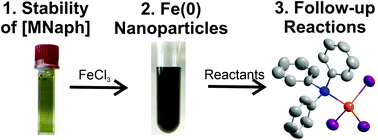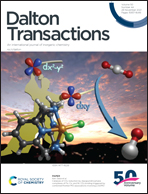Insights into the naphthalenide-driven synthesis and reactivity of zerovalent iron nanoparticles†
Abstract
The chemical and thermal stability of alkali metal naphthalenides as powerful reducing agents are examined, including the type of alkali metal ([LiNaph] and [NaNaph]), the type of solvent (THF, DME), the temperature (−30 to +50 °C), and the time of storage (0 to 12 hours). The stability and concentration of [LiNaph]/[NaNaph] are quantified via UV-Vis spectroscopy and the Lambert–Beer law. As a result, the solutions of [LiNaph] in THF at low temperature turn out to be most stable. The decomposition can be related to a reductive polymerization of the solvent. The most stable [LiNaph] solutions in THF are exemplarily used to prepare reactive zerovalent iron nanoparticles, 2.3 ± 0.3 nm in size, by reduction of FeCl3 in THF. Finally, the influence of [LiNaph] and/or remains of the starting materials and solvents upon controlled oxidation of the as-prepared Fe(0) nanoparticles with iodine in the presence of selected ligands is evaluated and results in four novel, single-crystalline iron compounds ([FeI2(MeOH)2], ([MePPh3][FeI3(Ph3P)])4·PPh3·6C7H8, [FeI2(PPh3)2], and [FeI2(18-crown-6)]). Accordingly, reactive Fe(0) nanoparticles can be obtained in the liquid phase via [LiNaph]-driven reduction and instantaneously reacted to give new compounds without remains of the initial reduction (e.g. LiCl, naphthalene, and THF).



 Please wait while we load your content...
Please wait while we load your content...